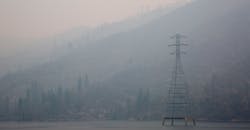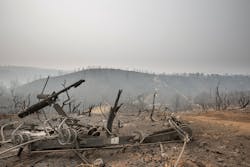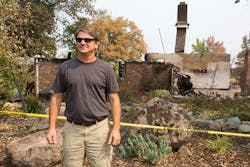In the Heat of the Blaze: WAPA Powers Local Communities
July 23 marked the beginning of the Carr Fire in northern California. CNN reported that it began as the result of a flat tire on a trailer; the motorist continued driving and the trailer’s rim scraped the asphalt, sending sparks into the nearby dry brush.
High temperatures and extreme drought conditions compounded the problem, and the blaze rapidly grew to uncontrollable proportions. It ultimately became the sixth most destructive wildfire in California’s history, threatening many transmission lines and customers in the Sierra Nevada region. Once again, WAPA employees responded to disaster.
Unified Response
The fire quickly reached Trinity County and the southern part of Shasta County. As the disaster response was kicking off for WAPA, an incident management structure was stood up with the emergency operating center at headquarters and the Sierra Nevada regional office in Folsom, California. WAPA crews came together in a unified response consisting of craft, technical and support personnel across WAPA.
“The people on the front lines are in the most stressful situations,” said Executive Vice President and Chief Operating Officer Kevin Howard. “Our goal was to establish a support network where we could help them with what they needed. It required a broad team.”
The dispatch team in Folsom acted quickly to de-energize the lines, allowing firefighters and WAPA crews in the area to work safely.
“The Carr Fire didn’t impact our facilities immediately,” said Supervisory Power System Dispatcher Christine Henry. “We started seeing impacts as the fire raged out of control the evening of July 26. We had a dozen or so lines that evening relay out of service.”
As the fire grew, fiber on the lines was damaged, leaving dispatch unable to see what was happening to the system. Henry compared the situation to driving on the freeway while blindfolded. With no remote access, the dispatchers’ only option was to send personnel to substations to perform manual switching. These employees acted as the eyes, ears and hands of the
dispatchers.
Protection and Communications Craftsman Dave Scharton and Foreman II Electrician Larry Torres rushed to Scharton’s home to print the documents necessary to perform the switching. On the way back, they noticed one of the power poles next to the road was on fire.
“This thing was about to fall,” Torres said. “I stepped on the gas to get through, grabbed the switching and started working our way back. When we got back to that pole, it was laying in the road. We had just missed it landing on us.”
Communications needed to be reestablished with the substations to give dispatchers control back over the system.
“I was on leave when I got a call saying they needed me in Redding,” said Foreman III Electronic Integrated Systems Mechanic Leader Daryl Rictor. “We got through all the National Guard fire checkpoints to Keswick Substation. When we got there, we saw a lot of alarms and started working right away.”
Rictor and two other technicians worked to get three substations back online. They arrived on the scene, analyzed what needed to be done and worked through the night and weekend to get the systems restored. Dispatchers were then finally able to take control.
“We go through the annual exercises, but during the real issue your adrenaline is pumping a lot more,” Rictor said. “It was very interesting and surreal, and sad at the same time.”
City Connections
WAPA line crews worked closely with the Bureau of Reclamation to ensure generating units were online and providing power to keep Trinity County energized. WAPA has a radial feed for Trinity County, and if the fire destroyed the 230-kV Trinity-to-Carr line that feeds Trinity Substation, all of Trinity County would lose power. Reclamation worked with WAPA on islanding the 60-kV line to protect Trinity’s load, allowing the power to flow while WAPA’s lines were affected by the blaze.
“Several of the power restorations have depended on black-starting Trinity Powerplant,” said Trinity Public Utilities District General Manager Paul Hauser. “This had never been done prior to this emergency.”
WAPA moved a diesel portable generator from Maxwell Substation, which was four hours away, to Weaverville to provide station service to Trinity. While bringing the plant back online, Trinity PUD had to work directly with Reclamation over the phone to add load one half-megawatt at a time to avoid tripping the plant off.
“Having never done this before, it was much more sensitive than we imagined it would be,” Hauser said. “But we ran through that routine half a dozen times now and we’ve gotten pretty good at it.”
The fires and various events have caused a total of eight systemwide outages for Trinity PUD, but Hauser explained that residents were incredibly supportive of the efforts to restore power.
“Without the folks at WAPA, I could not imagine what it would be like going through this,” Hauser said. “This is just a tremendous partnership.”
City of Redding Electric faced its own difficulties, with transmission lines failing faster than the utility could provide generation. The utility contended with overloading, rolling blackouts, low gas pressure preventing them from running generators, and complications from the abundant smoke.
“In the heat of this, we were down to one radial feed from WAPA. We were hanging by a thread,” said Redding Electric Utility Director Daniel Beans. “We were essentially islanded. We had to produce all of our power.”
Beans explained that City of Redding Electric employees did everything they could to keep the lights on, and WAPA played a big part in that effort. Although so much was going wrong, they kept service going in partnership with WAPA. He used one word to describe the situation: astounding.
Beans said that the transmission lines’ rights of way and vegetation management by City of Redding Electric and WAPA played a large part in slowing the fire down, giving residents more time to evacuate.
Too Close to Home
Many of the Carr Fire responders across agencies have been affected directly by the tragedy. Foreman III Lineman Brian Adams was one of several linemen on the Redding crew to have been evacuated.
“I have to give it to my employees,” Adams said. “Even though a lot of them and their families are evacuated, they still show up every day for work. They know the importance of getting this line back up for our customers.”
“When you lose your home, you lose everything,” said Power System Dispatcher Ray Zeller, who lost his house to the fire. “We had a little time to get some things out. We got some pictures and some family heirlooms, but we ended up losing a lot more important things.”
The Zellers’ friends, family and coworkers stepped up to help. Dispatchers in the Folsom office collected money for the first day he returned to work. He explained that in Folsom, coworkers take care of one another like a family.
“Volunteers have come out to help us sift through the ash to find some of my wife’s jewelry and other things we had in our home,” Zeller said. “The community has stepped forward and everyone is trying to do a little bit to help all of us that have lost our homes.”
Coming Together
As of Aug. 20, the Carr Fire had affected 229,651 acres. It had destroyed more than 1,000 homes and damaged nearly 300 more. Fortunately, though, it was 91% contained by that date.After a long, difficult fight, the end was finally near.
“I have to take my hat off to the crews out in the field,” Howard said.
“This experience has confirmed to me once again that we have the best people in all of government, and we are committed always to serving like our lights depend on it.” Administrator and CEO Mark A. Gabriel echoed Howard’s sentiment. “We cannot predict tragedies such as this one,” he says, “but time and again our dedicated crews have proven they will rise to meet them. I could not possibly be more proud of the selflessness and devotion demonstrated by WAPA employees in the most difficult of situations. Their incredible response here and elsewhere has not gone unrecognized.”
Travis Weger ([email protected]) is a public affairs specialist for WAPA. He traveled to California to document the response to the fires.
About the Author
Travis Weger
Public Affairs Specialist
Travis Weger is a public affairs specialist for Western Area Power Administration.






